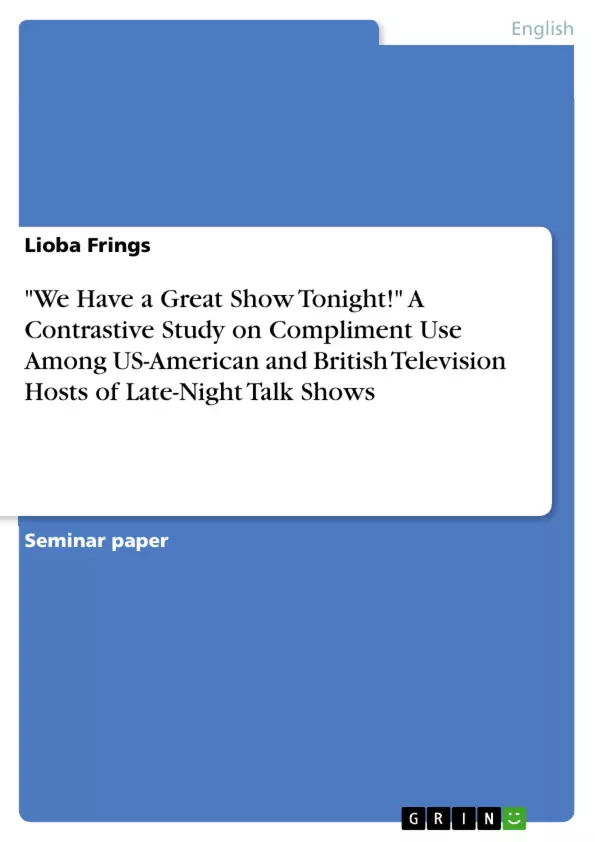How do US-American and British TV show hosts of talk shows differ in terms of compliment use? In what part of the show, how often, on what topic and in which context do they use compliments? This paper aims at answering these questions with a focus on late-night talk shows, exemplarily shown with one episode in each case. The US-American late-night talk show that was chosen to take data from is The Tonight Show Starring Jimmy Fallon, the British counterpart that was picked for this compliment research is The Jonathan Ross Show, concentrating on the compliments of the hosts, namely Jimmy Fallon and Jonathan Ross.
First there will be an overview of previous research on compliments on the one hand and talk shows on the other, coming to the method that has been chosen to gather the data, the structure of talk shows in general and in the case of the late-night talk shows this paper deals with, ending with presenting the results of this research on compliments.
Inhaltsverzeichnis (Table of Contents)
- Introduction
- Literature Review
- Method
- Talk Shows and Their Structure
- The Tonight Show Starring Jimmy Fallon
- The Jonathan Ross Show
- Results
- Position in Discourse and Frequency
- Context
- Compliment Topics
- Discussion
- Conclusion
Zielsetzung und Themenschwerpunkte (Objectives and Key Themes)
This paper aims to analyze the use of compliments by US-American and British late-night talk show hosts. It examines the frequency, position in discourse, topics, and context of compliments using two specific episodes, one from The Tonight Show Starring Jimmy Fallon and one from The Jonathan Ross Show. The paper seeks to understand how cultural differences in compliment use manifest in these two varieties of English.
- Cultural variations in compliment usage
- The role of compliments in late-night talk shows
- The relationship between compliment use and discourse structure
- The influence of cultural values on compliment topics
- A contrastive analysis of US-American and British English
Zusammenfassung der Kapitel (Chapter Summaries)
- Introduction: This chapter sets the stage for the research by outlining the research question and providing background information on late-night talk shows. It highlights the absence of prior research on compliment use in this genre and argues for the suitability of this format for investigating linguistic features like compliments.
- Literature Review: This chapter reviews previous studies on talk shows, focusing on their argumentative structures and social functions. It also examines existing research on compliments, highlighting the common topics and defining the concept of a compliment for the purpose of this research.
- Method: This chapter explains the methodological approach used in this paper, focusing on the discourse analytical method applied to the selected episodes. It describes the rationale for choosing The Tonight Show Starring Jimmy Fallon and The Jonathan Ross Show, outlining the structural similarities and the date of the selected episodes. The chapter further clarifies the data corpus, including the exclusion of guests' responses and the selection of compliments uttered solely by the hosts.
- Talk Shows and Their Structure: This chapter details the structure of late-night talk shows in general and the specific features of The Tonight Show Starring Jimmy Fallon and The Jonathan Ross Show. It provides information about the host's role, the types of guests, and the general format of the shows.
Schlüsselwörter (Keywords)
The paper focuses on key themes such as compliment use, late-night talk shows, US-American English, British English, contrastive analysis, discourse structure, cultural variations, and compliment topics. It examines the linguistic features of compliments in the context of a specific genre and how they reflect cultural differences in communication.
- Citar trabajo
- Lioba Frings (Autor), 2014, "We Have a Great Show Tonight!" A Contrastive Study on Compliment Use Among US-American and British Television Hosts of Late-Night Talk Shows, Múnich, GRIN Verlag, https://www.grin.com/document/368134



